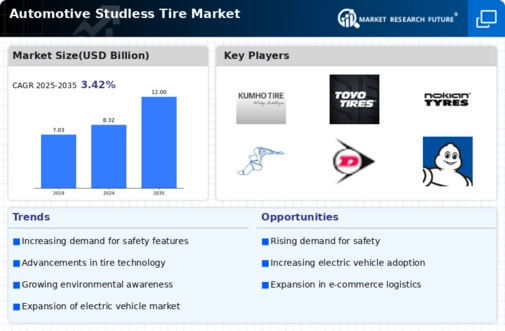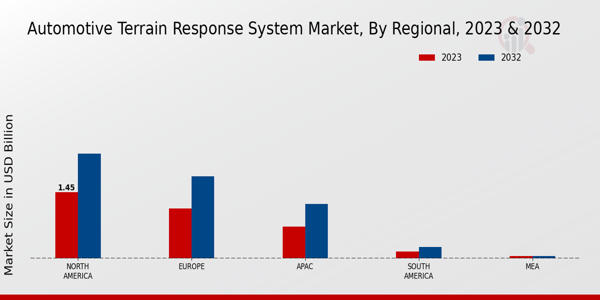Market Growth Projections
The Global Automotive Studless Tire Market Industry is poised for growth, with projections indicating a market value of 8.32 USD Billion in 2024 and a potential increase to 12.0 USD Billion by 2035. This growth reflects a compound annual growth rate (CAGR) of 3.42% from 2025 to 2035. The increasing demand for studless tires, driven by factors such as safety concerns, technological advancements, and environmental regulations, suggests a robust market landscape. As manufacturers continue to innovate and adapt to consumer preferences, the market is likely to experience sustained expansion in the coming years.
Growing Demand for Safety Features
The Global Automotive Studless Tire Market Industry experiences a notable increase in demand for safety features in vehicles. Consumers are increasingly prioritizing safety, particularly in regions with harsh winter conditions. Studless tires offer enhanced traction on icy and snowy surfaces, which is crucial for preventing accidents. This trend is reflected in the projected market value of 8.32 USD Billion in 2024, indicating a robust consumer preference for safer driving options. As manufacturers innovate to meet these safety demands, the market is likely to expand further, potentially reaching a value of 12.0 USD Billion by 2035.
Increasing Vehicle Production and Sales
The Global Automotive Studless Tire Market Industry is significantly influenced by the increasing production and sales of vehicles worldwide. As more consumers purchase vehicles, particularly in regions prone to winter weather, the demand for studless tires rises correspondingly. This trend is particularly evident in emerging markets where vehicle ownership is on the rise. The market's projected value of 8.32 USD Billion in 2024 underscores the correlation between vehicle sales and tire demand. Furthermore, as manufacturers ramp up production to meet consumer needs, the market is likely to see sustained growth, potentially reaching 12.0 USD Billion by 2035.
Consumer Awareness and Education on Tire Safety
Consumer awareness and education regarding tire safety significantly impact the Global Automotive Studless Tire Market Industry. As consumers become more informed about the importance of tire performance in adverse weather conditions, the demand for studless tires increases. Educational campaigns by automotive associations and manufacturers highlight the benefits of using studless tires for winter driving, contributing to a shift in consumer purchasing behavior. This heightened awareness is likely to support market growth, with projections indicating a market value of 8.32 USD Billion in 2024. As consumers prioritize safety and performance, the market may continue to flourish.
Technological Advancements in Tire Manufacturing
Technological advancements in tire manufacturing play a pivotal role in the Global Automotive Studless Tire Market Industry. Innovations such as improved rubber compounds and tread designs enhance the performance of studless tires, providing better grip and durability. These advancements not only cater to consumer preferences for high-performance tires but also align with environmental sustainability efforts. As manufacturers adopt eco-friendly practices, the market is expected to grow steadily, with a projected CAGR of 3.42% from 2025 to 2035. This growth trajectory suggests that technological improvements will continue to drive consumer interest and market expansion.
Environmental Regulations and Sustainability Trends
The Global Automotive Studless Tire Market Industry is increasingly shaped by environmental regulations and sustainability trends. Governments worldwide are implementing stricter regulations regarding vehicle emissions and tire performance, prompting manufacturers to innovate in eco-friendly tire solutions. Studless tires, often made from sustainable materials, align with these regulatory frameworks, appealing to environmentally conscious consumers. This shift towards sustainability is expected to drive market growth, as evidenced by the projected CAGR of 3.42% from 2025 to 2035. As manufacturers adapt to these trends, the market is likely to expand, reflecting a growing commitment to environmental responsibility.











